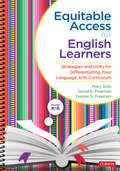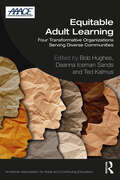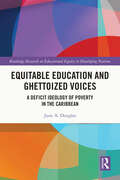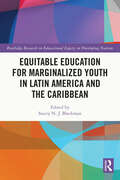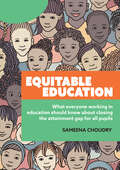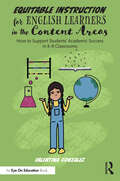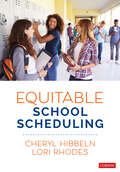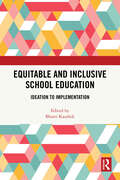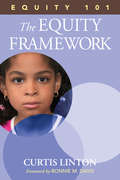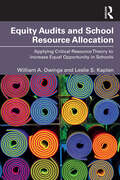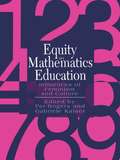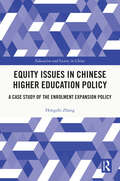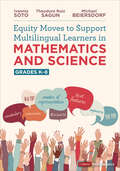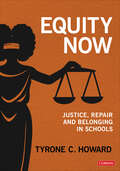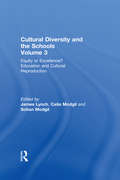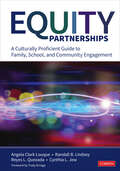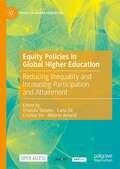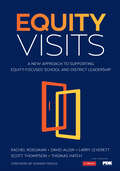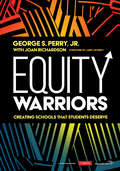- Table View
- List View
Equitable Access for English Learners, Grades K-6: Strategies and Units for Differentiating Your Language Arts Curriculum
by Yvonne S. Freeman David E. Freeman Mary SotoPlain and simple: until our English learners have equitable access to the curriculum, they’ll continue to struggle with subject area content. And if you’re relying on add-on’s to fit in from your language arts basal or a supplementary program, Mary Soto, David Freeman, and Yvonne Freeman are here to equip you with much more effective, efficient, and engaging strategies for helping your English learners read and write at grade level. One assurance right from the start: Mary, David, and Yvonne are not suggesting you reinvent your curriculum. Instead, Equitable Access for English Learners, Grades K-6, focuses on how to fortify foundational practices already in place. First, you’ll learn more about the Equitable Access Approach, then it’s time to dive into the book’s four units of study. Drawing on each unit’s many strategies, you’ll discover how to apply them to any unit in your own language arts curriculum and start differentiating: How to draft and implement language objectives to help English learners meet academic content standards How to make instructional input comprehensible, including translanguaging strategies that draw on your students’ first languages when you don’t know how to speak them How to utilize the characteristics of text to support readers, along with a rubric for determining a text’s cultural relevance How to build students’ academic content knowledge and develop academic language proficiency Each unit addresses a commonly taught topic in today’s language arts programs and comes with ready-to-go review and preview activities, key strategies, grade-level adaptations, reflection exercises, and printable online resources. Taken as a whole, they constitute an all-new approach for providing that equitable and excellent access our English learners so rightfully deserve. "When you adopt our Equitable Access Approach, your students will not only thrive, they’ll also find your language arts curriculum much more meaningful and engaging." —Mary Soto, David E. Freeman, and Yvonne S. Freeman
Equitable Adult Learning: Four Transformative Organizations Serving Diverse Communities (American Association for Adult and Continuing Education)
by Bob Hughes Deanna Iceman Sands Ted KalmusThis book provides case studies written by practitioners from four organizations serving diverse adult learners in equitable, inclusive, and just ways. Their work employs an adapted version of the Education Deans for Justice and Equity Framework for Assessment and Transformation, a comprehensive tool grounded in research on equity and justice. This is one of the first published uses of that framework. The editors situate this book in the history and need for increased equity and justice in adult education. They apply participatory action research to assist the four organizations in telling their stories. Authors of the organization chapters highlight their history and context in relation to their organizational structures, systems, policies, and procedures. Editors provide a cross-case analysis of the four case studies. This book will appeal to academics in adult education, social justice education, qualitative research methods, and organizational development. Organizations and practitioners will find exemplars of how to live into their intentions to be equitable and just.
Equitable Education and Ghettoized Voices: A Deficit Ideology of Poverty in The Caribbean (Routledge Research on Educational Equity in Developing Nations)
by June A. DouglasThis book centres the voices of a group of marginalized residents in Grenada’s ghetto to examine questions of poverty and survival and how, within this context, residents are able to focus on improvement and equity for their children through education.As a developing nation in the Caribbean influenced by both its British colonial past and its proximity to the United States, Grenada is still rife with poverty, and access to quality education is limited. The author examines this tradition of the ghetto as the centre of community and a force for positivity among youth, and develops a theory of education and deficit poverty through examples of citizens living in a developing state. Using functionalism, life course, and other systems theories, the book examines how institutions can support communities, and, in contrast, how families in poverty support themselves in the wake of system failure, to the extent that some children become successful university graduates, entrepreneurs, and world travellers. A cutting analysis of the development of equity through education in states left behind by colonialism and globalisation, this book offers new understandings of survival and criminality caused by deficit poverty. It will appeal to scholars, faculty, and researchers with interests in international education, education and globalisation, small island states, life course theory, systems theory, and anthropology.
Equitable Education for Marginalized Youth in Latin America and the Caribbean (Routledge Research on Educational Equity in Developing Nations)
by Stacey N. J. BlackmanThis edited volume examines the thrust towards equity in education for marginalized and out-of-school youth, as well as youth with disabilities, in countries located in the Global South. Using a critical cross-cultural lens to interrogate the historical, empirical, and theoretical discourses associated with achieving UNESCO’s equity in education agenda, the book showcases the work of scholars from developed and developing nations in examining inclusive education. Drawing attention to the nature, impact, and effects of marginalization, the book ultimately demonstrates the ability of education systems in the Global South to be innovative and agile despite current resource challenges. This text will benefit scholars, academics, and students in the fields of international and comparative education, education policy, and inclusion and special educational needs education more broadly. Those involved with Caribbean and Latin American studies, the sociology of education, and diaspora studies in general will also benefit from this volume.
Equitable Education: What everyone working in education should know about closing the attainment gap for all pupils
by Sameena ChoudryNever has a book on social justice and equitable education been so relevant.Recent events have highlighted the huge attainment gaps that exist for many pupils within the education system due to factors outside of their control. As the diversity of the pupil population increases, it is more important than ever to develop the skills, knowledge and understanding within the teaching profession around issues of equality and inclusion. This book provides trainees and teachers with an in-depth understanding of the complex issues related to the attainment of key groups of disadvantaged pupils, and practical strategies that can be deployed to address these gaps.Chapters focus on: social class, gender, English as an additional language, minority ethnic achievement, gypsy, Roma and travellers, refugee and asylum seekers, and those with special educational needs and disabilities. The book takes a stark look at the evidence and statistics, provides an overview of the key issues and considerations for each particular group, and suggests key resources and examples of good practice, along with case studies and points for reflection. Ultimately it encourages you to have high expectations of your pupils and to truly believe that you can help them realise their ambitions and aspirations. This is a powerful and timely consideration of the ways in which education has the capacity to make a difference. Packed full of evidence-informed strategies, this book considers the range of ways that schools can respond positively to build far greater equity for all…Sameena Choudry's contribution is authoritative and compelling and deserves our full attention.Dame Alison Peacock.
Equitable Instruction for English Learners in the Content Areas: How to Support Students’ Academic Success in K-8 Classrooms
by Valentina GonzalezIn Equitable Instruction for English Learners in the Content Areas, ESL expert Valentina Gonzalez shows you how to meet the needs of English learners in K-8 classrooms. With an emphasis on comprehensible input, the clear and accessible guidance in this book allows teachers to maintain a high level of instruction and hold all students to high standards while allowing English learners important opportunities to engage with key content area language and excel at subject-specific material. Demonstrating how equity is an essential component to teaching multilingual learners, this book includes engaging practical strategies catered to different grade levels, and it is essential reading for every teacher who works with multilingual learners.
Equitable School Scheduling
by Cheryl Hibbeln Lori RhodesTo understand a school’s values and priorities, look at its schedule. When schedules do not meet the instructional needs of students, the result is a pipeline from PreK through grade 12 that leaks students, an outcome disproportionately experienced by students of color and other marginalized student groups. This practical and thoughtful guide demonstrates how school and district scheduling teams can become "Architects of Equity"—highly effective teams who design schedules that reflect their commitment to student achievement and social-emotional wellbeing. Including strategies to shift collective mindsets around scheduling, organize and support teaching teams, and ensure fiscal responsibility in scheduling, Equitable School Scheduling is a vital resource for secondary school leaders committed to dismantling systemic inequities inherent in school structures. Readers will learn how to Self-assess site and/or district data through a deep examination of the course of study, site schedule(s), transcripts, and graduation cohort outcomes. Design and implement an Equitable Core—a guaranteed set of courses that all students experience as a part of a meaningful graduation. Prioritize underestimated and historically underserved students in the planning of the schedule. Equitable School Scheduling helps school and district administrators use scheduling as a tool to transform the leaky pipeline to graduation into a meaningful path to post-secondary success for all students.
Equitable School Scheduling
by Cheryl Hibbeln Lori RhodesTo understand a school’s values and priorities, look at its schedule. When schedules do not meet the instructional needs of students, the result is a pipeline from PreK through grade 12 that leaks students, an outcome disproportionately experienced by students of color and other marginalized student groups. This practical and thoughtful guide demonstrates how school and district scheduling teams can become "Architects of Equity"—highly effective teams who design schedules that reflect their commitment to student achievement and social-emotional wellbeing. Including strategies to shift collective mindsets around scheduling, organize and support teaching teams, and ensure fiscal responsibility in scheduling, Equitable School Scheduling is a vital resource for secondary school leaders committed to dismantling systemic inequities inherent in school structures. Readers will learn how to Self-assess site and/or district data through a deep examination of the course of study, site schedule(s), transcripts, and graduation cohort outcomes. Design and implement an Equitable Core—a guaranteed set of courses that all students experience as a part of a meaningful graduation. Prioritize underestimated and historically underserved students in the planning of the schedule. Equitable School Scheduling helps school and district administrators use scheduling as a tool to transform the leaky pipeline to graduation into a meaningful path to post-secondary success for all students.
Equitable and Inclusive School Education: Ideation to Implementation
by Bharti KaushikThis book highlights the strategies and approaches to the practice of equitable and inclusive school education, elaborating the role of various stakeholders such as teachers, special educators, parents, peers, teacher educators, educational administrators and Ed-tech firms.The aim of this book is to create an understanding of equitable and inclusive school education which is not restricted to children with disabilities but also includes children with different learning needs as well as those from socially and economically disadvantaged sections of society. The focus is on presenting practical strategies that are grounded in theory and supported with research. The significance of screening at the classroom level, development of need-based accessible learning teaching materials, customizing the pedagogy practices for inclusive classrooms, need-based examination accommodations, leveraging the potential of Information and Communication Technology (ICT) to elicit the participation of all and collaborative efforts toward realizing the optimum potential of each learner are a few basic ideas illustrated in the book with examples. The volume also discusses recent national and international policies for equitable and inclusive education, recommending courses of action for effective implementation of the existing provisions by teachers and educators.The book will be useful to students, researchers, teacher-educators, special educators, special education teacher educators, pre-service teachers and parents. It will also be an invaluable companion to in-service teachers, policymakers and educational administrators, curriculum developers and NGOs working in the field of inclusive education.
Equity 101- The Equity Framework: Book 1
by Curtis W. LintonEquity is key to eliminating achievement gaps This first volume of a four-book series outlines a simple, yet powerful approach to creating the expectations, rigor, relevancy, and relationships necessary for any child to succeed. Equity 101 describes school systems that have changed their climate, culture, and practices to foster high levels of achievement. Best-selling author Curtis Linton introduces the three essential characteristics of equity: Clear expectations for closing the achievement gap Commitment to rigorous curriculum Relationships that promote learning Readers will have access to online videos that are keyed to central concepts of the series.
Equity 101: Book 2
by Curtis W. Linton Bonnie M. DavisHelp a culture of equity grow and thrive in your school! This second book in the groundbreaking Equity 101 series takes on the cultures we come from and the culture we foster in our schools. When diversity is the norm, how do we create an equitable culture where everyone succeeds? Your path starts with increasing educators’ cultural competency, overcoming institutionalized factors that limit achievement, and implementing equitable practices that ensure individualized support for all students. Resources include: Real-life success stories to use as models Chapter-specific implementation exercises that take you from ideas to action A dedicated online community for professional support
Equity Audits and School Resource Allocation: Applying Critical Resource Theory to Increase Equal Opportunity in Schools
by Leslie S. Kaplan William A. OwingsEquity Audits and School Resource Allocation explores how to apply Critical Resource Theory (CReT) to conduct school equity audits, ultimately preparing educational leaders to find equity disparities, engage in more equitable resource allocation in their schools, and improve equal educational opportunity for every student. With case study scenarios woven throughout the book, the authors explore key equity factors, including per-pupil expenditures, poverty, teacher and principal quality, program equity, and achievement equity. They also walk through the process of implementing the 5-step CReT equity audit within a school district or school at any level. Owings and Kaplan also describe the communication and interpersonal factors that equity advocates will need to leverage to gain community support for equity process, considering the data, and rethinking their policies and practices. In today’s education context, the problems of equitably funding public schools and allocating learning resources to generate more equal opportunities and higher outcomes for traditionally underserved children are particularly relevant. This important book is designed for course use in leadership preparation programs, for practicing principals and superintendents, and for educational leadership scholars.
Equity In Mathematics Education: Influences Of Feminism And Culture
by Gabriele KaiserThis text provides a critical overview of current thinking about equity issues in the teaching and learning of mathematics. Grounded in feminist theories of curriculum change and a broad range of cultural perspectives, the new approaches described here go beyond "special programmes" and "experimental treatments" designed to correct perceived problems and deficits. Instead they establish how improved instructional practices and a fuller understanding of the nature of the mathematical enterprise can overcome the systemic obstacles that have thwarted women's participation in this important field.; This book will appeal to all those who are interested in the mathematical education of women, including teachers, parents, administrators and researchers.
Equity Issues in Chinese Higher Education Policy: A Case Study of the Enrolment Expansion Policy (ISSN)
by Hongzhi ZhangInvestigating the highly influential enrolment expansion policy in Chinese higher education, this book outlines how educational equity issues were understood and addressed in the formulation and implementation of the policy, and its impacts on the socio-economic fabric of China in the past decades.Drawing on Chinese policy documents and interviews with government and university representatives, Zhang examines the education system under the Mao era and the post-Mao era and outlines the different approaches to equity that have characterized education in China in the 20th and 21st centuries. Stephen Ball’s "policy cycle" is used as a framework to analyse the various contexts (text, discourse, and social practice) in which policy is formed. Zhang argues that education policy was not simply driven by concerns of equity but also by economic interests and political discourse. Zhang further goes on to analyse how education policy was implemented by provincial governments and highlights the tension between central policy and on-the-ground implementation.Bringing analysis of Chinese policy and research to a wider audience, this text will interest education policymakers and academics in the field of educational equity and higher education research.
Equity Moves to Support Multilingual Learners in Mathematics and Science, Grades K-8 (Corwin Mathematics Series)
by Ivannia Soto Theodore Sagun Michael BeiersdorfA strengths and assets-based approach to multilingual learner success As the number of multilingual learners (MLLs) in US schools continues to grow, educators need to learn the moves necessary to support the success of these students in mathematics and science. Equity Moves to Support Multilingual Learners in Mathematics and Science, Grades K-8 focuses on the literacy opportunities that MLLs can achieve when language scaffolds are taught alongside rigorous math and science content. It provides a framework teachers can use to develop equity-centered, scaffolded math, science, or STEAM lessons. Readers will find Anchor phenomena that demonstrate issues with lesson design and delivery and highlight areas to include language and content scaffolds Examples for honoring the languages of students, families, and communities Culturally responsive techniques and easy-to-use tables featuring the equity moves Vignettes showcasing the equity move in the classroom setting A focus on four language demands: vocabulary, discourse, multiple modes of representation, and text features With an assets-based approach to what MLLs can do, this book helps teachers unpack the language demands of mathematics and science and encourages reflection of their own practices in scaffolding for language and culture.
Equity Moves to Support Multilingual Learners in Mathematics and Science, Grades K-8 (Corwin Mathematics Series)
by Ivannia Soto Theodore Sagun Michael BeiersdorfA strengths and assets-based approach to multilingual learner success As the number of multilingual learners (MLLs) in US schools continues to grow, educators need to learn the moves necessary to support the success of these students in mathematics and science. Equity Moves to Support Multilingual Learners in Mathematics and Science, Grades K-8 focuses on the literacy opportunities that MLLs can achieve when language scaffolds are taught alongside rigorous math and science content. It provides a framework teachers can use to develop equity-centered, scaffolded math, science, or STEAM lessons. Readers will find Anchor phenomena that demonstrate issues with lesson design and delivery and highlight areas to include language and content scaffolds Examples for honoring the languages of students, families, and communities Culturally responsive techniques and easy-to-use tables featuring the equity moves Vignettes showcasing the equity move in the classroom setting A focus on four language demands: vocabulary, discourse, multiple modes of representation, and text features With an assets-based approach to what MLLs can do, this book helps teachers unpack the language demands of mathematics and science and encourages reflection of their own practices in scaffolding for language and culture.
Equity Now: Justice, Repair, and Belonging in Schools
by Tyrone C. HowardIf not now, when? Anchored in the tenets of justice, repair, and belonging, Equity Now is a comprehensive guide for educators that emphasizes the urgent need for immediate action to dismantle systemic barriers in education. Aimed at K-12 professionals at all levels of the education system, the book urges us to move beyond individual efforts by applying an equity lens to our policies and practices. Through honest, sustained, and critical dialogues in "brave spaces," educators can address disparities and create equity-centered school communities. Equity Now proposes a solutions-oriented approach to fostering welcoming, affirming, responsive, and rigorous learning environments. Author Tyrone C. Howard, one of the leading authorities on issues related to racial inequality in our schools, provides An equity framework grounded in justice, repair, and belonging A clear vision of equity-focused leadership Essential practices, strategies, and resources for classroom teachers Suggestion for engaging parents, families and caregivers in schools Recommendations for engaging data in an equity based way Reflection questions and additional resources at the close of each chapter This book is a must-read for educators, administrators, and policymakers who are committed to creating conditions in which our children can reach their highest potential.
Equity Now: Justice, Repair, and Belonging in Schools
by Tyrone C. HowardIf not now, when? Anchored in the tenets of justice, repair, and belonging, Equity Now is a comprehensive guide for educators that emphasizes the urgent need for immediate action to dismantle systemic barriers in education. Aimed at K-12 professionals at all levels of the education system, the book urges us to move beyond individual efforts by applying an equity lens to our policies and practices. Through honest, sustained, and critical dialogues in "brave spaces," educators can address disparities and create equity-centered school communities. Equity Now proposes a solutions-oriented approach to fostering welcoming, affirming, responsive, and rigorous learning environments. Author Tyrone C. Howard, one of the leading authorities on issues related to racial inequality in our schools, provides An equity framework grounded in justice, repair, and belonging A clear vision of equity-focused leadership Essential practices, strategies, and resources for classroom teachers Suggestion for engaging parents, families and caregivers in schools Recommendations for engaging data in an equity based way Reflection questions and additional resources at the close of each chapter This book is a must-read for educators, administrators, and policymakers who are committed to creating conditions in which our children can reach their highest potential.
Equity Or Excellence? Educ & C
by James Lynch Sohan Modgil Celia ModgilFirst published in 1992. Routledge is an imprint of Taylor & Francis, an informa company.
Equity Partnerships: A Culturally Proficient Guide to Family, School, and Community Engagement
by Randall B. Lindsey Reyes L. Quezada Cynthia L. Jew Angela R. Clark-LouqueHow often do you hear, "The only parents who showed were the parents who didn’t need to be here." But how often do you consider time of day, lack of child care, cost of dinner, transportation, language of the presentation, even relevance of the topic—all real-world barriers for families of our historically underserved students. Here at last is a resource that will open up access and reveal all-new ways to forge more culturally inclusive partnerships with families and communities . . . partnerships that extend well beyond parent-teacher conferences, PTA meetings, and the occasional bake sale. The two big services Equity Partnerships provides? Using the Tools of Cultural Proficiency, you’ll Discover new concepts and strategies to engage families and communities—and reduce, if not eliminate, barriers--through four essential principles: communication, connection, collaboration, and community Engage in frequent opportunities to reflect on your own assumptions and values, then collaborate with colleagues to co-create systemic practices and policies for devising, implementing, and assessing family and community engagement actions in your schools and districts We know inherently that family and community engagement is critical to the success of our students. Let Equity Partnerships be your go-to tool for breaking down the walls that for too long have limited all of us. "Raising the next generation is a shared responsibility and privilege. These authors have been first responders for decades by promoting Cultural Proficiency as a means to ensure equity and access for all. In Equity Partnerships, they identify the powerful and critical link of family, school, and community engagement to strengthen families, build community support, and increase student success." --TRUDY ARRIAGA, Associate Dean for Equity and Outreach, California Lutheran University, and Coauthor of Opening Doors
Equity Partnerships: A Culturally Proficient Guide to Family, School, and Community Engagement
by Randall B. Lindsey Reyes L. Quezada Cynthia L. Jew Angela R. Clark-LouqueHow often do you hear, "The only parents who showed were the parents who didn’t need to be here." But how often do you consider time of day, lack of child care, cost of dinner, transportation, language of the presentation, even relevance of the topic—all real-world barriers for families of our historically underserved students. Here at last is a resource that will open up access and reveal all-new ways to forge more culturally inclusive partnerships with families and communities . . . partnerships that extend well beyond parent-teacher conferences, PTA meetings, and the occasional bake sale. The two big services Equity Partnerships provides? Using the Tools of Cultural Proficiency, you’ll Discover new concepts and strategies to engage families and communities—and reduce, if not eliminate, barriers--through four essential principles: communication, connection, collaboration, and community Engage in frequent opportunities to reflect on your own assumptions and values, then collaborate with colleagues to co-create systemic practices and policies for devising, implementing, and assessing family and community engagement actions in your schools and districts We know inherently that family and community engagement is critical to the success of our students. Let Equity Partnerships be your go-to tool for breaking down the walls that for too long have limited all of us. "Raising the next generation is a shared responsibility and privilege. These authors have been first responders for decades by promoting Cultural Proficiency as a means to ensure equity and access for all. In Equity Partnerships, they identify the powerful and critical link of family, school, and community engagement to strengthen families, build community support, and increase student success." --TRUDY ARRIAGA, Associate Dean for Equity and Outreach, California Lutheran University, and Coauthor of Opening Doors
Equity Policies in Global Higher Education: Reducing Inequality and Increasing Participation and Attainment (Issues in Higher Education)
by Alberto Amaral Orlanda Tavares Cristina Sin Carla SáThis book discusses and analyses global policies and practices aimed at promoting equity in higher education participation and attainment. Although the massification of higher education systems has facilitated the participation of students from deprived backgrounds, socioeconomic inequalities persist in access to the most prestigious institutions and programmes. Privileged students benefit from a number of advantages in the competition for selective and scarce places: access to information, lower aversion to debt, higher expectations, better previous schooling and higher academic achievement. The chapters present a critical analysis of equity policies in different countries – with or without affirmative action policies, within a context of neoliberal policies or within a social democratic model – and the reasons why they have failed to promote equity and fairness, preventing students from achieving their full educational potential.This is an open access book.
Equity Visits: A New Approach to Supporting Equity-Focused School and District Leadership
by David Allen Larry Leverett Scott T. Thompson Thomas C. Hatch Rachel D. RoegmanBecause equity and instruction are inextricably bound Why are equity visits such a critical first step to increasing opportunity and access for our under-served students? Because they take instructional rounds to a new level, providing a powerful lens for investigating the intersections of equity and instruction. After all, how can we possibly deliver equitable learning experiences, opportunities, and outcomes for our students, without first pinpointing problems of practice? That’s where Equity Visits will prove absolutely indispensable to district and school administrators. It details how to combine a strong focus on instruction with explicit, intentional efforts to address systemic inequities. Inside you’ll find A range of data collection activities and tools to target central issues of equity in your school Clear guidelines on how to investigate the ways instructional practices, structures, and beliefs lead to inequitable educational experiences—and how these are often masked in the day-to-day life of schools and districts A frank discussion of how to make race and racism an explicit part of investigating and addressing educational inequities Voices of school and district leaders who have taken crucial first steps to become "equity warriors" Recommendations on how to develop policies, initiatives, and practices to confront those inequities Few dispute that instructional improvement must be a central focus of educational leadership, but for too long achieving educational equity has been absent from the conversation. Here is your opportunity to ensure equity occupy a central spot in data collection and analysis, and be explicitly discussed at all levels of your school or district organization. In short, essential reading and doing for all administrators!
Equity Visits: A New Approach to Supporting Equity-Focused School and District Leadership
by David Allen Larry Leverett Scott T. Thompson Thomas C. Hatch Rachel D. RoegmanBecause equity and instruction are inextricably bound Why are equity visits such a critical first step to increasing opportunity and access for our under-served students? Because they take instructional rounds to a new level, providing a powerful lens for investigating the intersections of equity and instruction. After all, how can we possibly deliver equitable learning experiences, opportunities, and outcomes for our students, without first pinpointing problems of practice? That’s where Equity Visits will prove absolutely indispensable to district and school administrators. It details how to combine a strong focus on instruction with explicit, intentional efforts to address systemic inequities. Inside you’ll find A range of data collection activities and tools to target central issues of equity in your school Clear guidelines on how to investigate the ways instructional practices, structures, and beliefs lead to inequitable educational experiences—and how these are often masked in the day-to-day life of schools and districts A frank discussion of how to make race and racism an explicit part of investigating and addressing educational inequities Voices of school and district leaders who have taken crucial first steps to become "equity warriors" Recommendations on how to develop policies, initiatives, and practices to confront those inequities Few dispute that instructional improvement must be a central focus of educational leadership, but for too long achieving educational equity has been absent from the conversation. Here is your opportunity to ensure equity occupy a central spot in data collection and analysis, and be explicitly discussed at all levels of your school or district organization. In short, essential reading and doing for all administrators!
Equity Warriors: Creating Schools That Students Deserve
by Joan Richardson George S. PerryAdvance equity by learning to crack the system’s codes We must act now, using what we already know, to advance equity and raise the achievement of every student. With three decades of leading equity work across the country, George S. Perry Jr. issues a call to action for educational leaders who are willing to fight the fight for equity for all students. School and district leaders will encounter roadblocks as they enact systemic change, but Equity Warriors introduces practical, realistic, and strategic approaches for navigating those barriers. Equity Warriors equips education leaders with the moves they can make today to achieve the vision that every student becomes a high achiever by Providing real school and district examples of systemic equity efforts Demonstrating the parallel work that school and district teams must do to achieve and sustain systemic change Cracking the codes in the domains of politics, diplomacy, and warfare to achieve the equity agenda. Equity Warriors is a must read for leaders at all levels of the system who have chosen to be in this fight and are ready to do what it takes to make the system work for all students.
